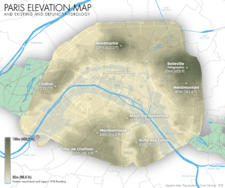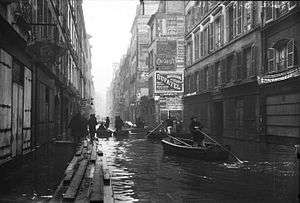1910 Great Flood of Paris

The 1910 Great Flood of Paris (French: Crue de la Seine de 1910) was a catastrophe in which the Seine River, carrying winter rains from its tributaries, flooded the Paris conurbation, France. The Seine water level rose eight metres above the ordinary level.[1]
Chronology
In late January 1910, following months of high rainfall, the Seine River flooded Paris when water pushed upwards from overflowing sewers and subway tunnels, and seeped into basements through fully saturated soil. The waters did not overflow the river's banks within the city, but flooded Paris through tunnels, sewers, and drains. In neighbouring towns both east and west of the capital, the river rose above its banks and flooded the surrounding terrain directly.
Winter floods were a normal occurrence in Paris but, on 21 January, the river began to rise more rapidly than normal. Over the course of the following week, thousands of Parisians evacuated their homes as water infiltrated buildings and streets throughout the city, shutting down much of Paris' basic infrastructure. Police, fire-fighters, and soldiers moved through waterlogged streets in boats to rescue stranded residents from second-story windows and to distribute aid. Refugees gathered in makeshift shelters in churches, schools, and government buildings. Although the water threatened to overflow the tops of the quay walls that line the river, workmen were able to keep the Seine back with hastily built levees.
Once water invaded the Gare d'Orsay rail terminal, its tracks soon sat under more than a metre of water. To continue moving throughout the city, residents travelled by boat or across a series of wooden walkways built by government engineers and by Parisians themselves.
On 28 January the water reached its maximum height at 8.62 metres (28.28 feet) above its normal level.
Consequences
Estimates of the flood damage reached some 400 million francs, or $1.5 billion in today's money. The flooding lasted nearly a week, according to one report.[2]
Because of the water rising over time there were no deaths. The water achieved its highest level after 10 days and after 35 days the water was gone completely.
Image gallery
-

Pont Alexandre III during the flood
-

rue de la Convention
-
.jpg)
Avenue Félix-Faure
-

Cour de Rome, gare Saint-Lazare
-

Rue de Poitiers
-

Rue de Seine
-

Rue Trousseau
-

Trousseau Square
References
- ↑ "Is Paris prepared if Seine floods?". BBC. 27 December 2013. Retrieved 27 September 2014.
- ↑ 7 January 2010, The Guardian, Flooding in Paris in 1910 Accessed Dec 16 2010
Sources
Jeffrey H. Jackson, Paris Under Water: How the City of Light Survived the Great Flood of 1910 (NY: Palgrave Macmillan, 2010)
External links
![]() Media related to Great flood of Paris in 1910 at Wikimedia Commons
Media related to Great flood of Paris in 1910 at Wikimedia Commons
- Crue de la Seine (French)
- Postcard collection of flood photographs
- Images by photographer Pierre Petit
- Assemblée nationale website on the 1910 flood (French)
- The flood's impact on Parisian hospitals (French)
- L'explosition virtuelle Paris Inondé 1910: Galerie des bibliothèques, Ville de Paris
- Revisiting the flood 100 years later